- Publisher's Note
- Editorial
- Sixteen printmakers talk about their work
- The Imprinted Body
- A Chai with Vijay Bagodi
- The Wood Engravings of Haren Das
- A Physical Perception of Matter
- Feminine Worlds
- A Rich Theater of Visuality
- A Medley of Tradition
- Decontextualizing Reality
- Printmaking and/as the New Media
- Conversations with Woodcut
- Persistence of Anomaly
- Sakti Burman - In Paris with Love
- Lalu Prasad Shaw: The Journey Man
- Future Calculus
- A Note on Prints, Reproductions and Editions
- A Basic Glossary of Print Media
- The Art of Dissent: Ming Loyalist Art
- Vishnu: Hinduism's Blue-Skinned Savior at the Brooklyn Museum of Art
- Twelfth edition of Toronto International Art Fair
- Vintage Photographs of the Maharajas
- Göteborg International Biennial
- A Museum, a Retrospect & a Centenary for K.K. Hebbar:
- Recent and Retrospective: Showcase of Shuvaprasanna's Work
- "I Don't Paint To Live, I Live To Paint": Willem de Kooning
- Salvador Dali Retrospective: I am Delirious, Therefore I am
- To Be Just and To Be Fair
- Census of Senses: Investigating/Re-Producing Senses?
- Between Worlds: The Chittaprosad Retrospective
- Awesomely Artistic
- Random Strokes
- Counter Forces in The Printmaking Arena and how to Counter them
- Shift in focus in the Indian Art Market
- What Happened and What's Forthcoming
- Art Bengaluru
- Mumbai Art Sighting
- Musings from Chennai
- Art Events Kolkata
- Previews
- In the News
ART news & views
To Be Just and To Be Fair
Volume: 4 Issue No: 21 Month: 10 Year: 2011
Review
by Haimanti Dutta Ray
 Kolkata: It is accepted by certain critics that modern Western art dates from 1863. The venue for this portentous birth was Paris, then the glittering cultural capital of Europe and the occasion, the controversial Salon des Refuses at which Edouard Manet first exhibited his epoch-making Dejeuner Sur l'herbe to a shocked public. This exhibition has since proved to be one of the most important of all time. In many ways, it ushered in new trends by emphasizing alternative views about the purpose and practice of art, cutting through the shifting atmosphere which had prevailed until then in French academic circles. It claimed a new role for the artist in a rapidly changing urban society, whose affluence came from the benefits of the industrial revolution. Henceforth, rather than following rules dating from the Italian Renaissance, artists would paint the world as they saw and experienced it.
Kolkata: It is accepted by certain critics that modern Western art dates from 1863. The venue for this portentous birth was Paris, then the glittering cultural capital of Europe and the occasion, the controversial Salon des Refuses at which Edouard Manet first exhibited his epoch-making Dejeuner Sur l'herbe to a shocked public. This exhibition has since proved to be one of the most important of all time. In many ways, it ushered in new trends by emphasizing alternative views about the purpose and practice of art, cutting through the shifting atmosphere which had prevailed until then in French academic circles. It claimed a new role for the artist in a rapidly changing urban society, whose affluence came from the benefits of the industrial revolution. Henceforth, rather than following rules dating from the Italian Renaissance, artists would paint the world as they saw and experienced it.
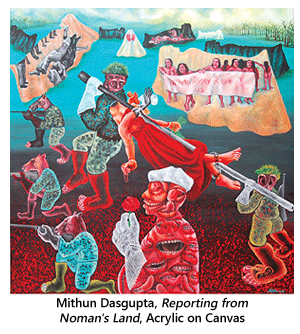 Movements of the politico-socio-religious kind always begin at the grass- root level. These gain momentum over a period of years, often decades, to turn itself into one of such gargantuan proportions that ultimately a revolution of sorts is ushered in. These movements affect almost all the echelons of our social strata and the people who perpetrate them are authors, artists and others from the creative field. It is the pledge of our political leaders and social activists that they would advocate, spread and implement justice at all the layers of our social hierarchy. War, terrorism, the rise of fundamentalism, suicidal assaults, genocide, mass human slaughter in the name of power politics, sexual abuse, etc. have become a part of our everyday existence, as it were. Today, the storming of Bastille which ushered in the French Revolution seems to be chimerical the way things are shaping out in the world. Modern times are ushering in crass terrorism around the world which is witnessing the rise of a single religious power. In the history of art, Pablo Picasso's famous mural painting, Guernica, is the greatest anti-war symbol ever to be painted by man and is an embodiment of peace. This particular artwork was conceived and created by Picasso as a reaction to the bombing of Guernica, Basque Country,
Movements of the politico-socio-religious kind always begin at the grass- root level. These gain momentum over a period of years, often decades, to turn itself into one of such gargantuan proportions that ultimately a revolution of sorts is ushered in. These movements affect almost all the echelons of our social strata and the people who perpetrate them are authors, artists and others from the creative field. It is the pledge of our political leaders and social activists that they would advocate, spread and implement justice at all the layers of our social hierarchy. War, terrorism, the rise of fundamentalism, suicidal assaults, genocide, mass human slaughter in the name of power politics, sexual abuse, etc. have become a part of our everyday existence, as it were. Today, the storming of Bastille which ushered in the French Revolution seems to be chimerical the way things are shaping out in the world. Modern times are ushering in crass terrorism around the world which is witnessing the rise of a single religious power. In the history of art, Pablo Picasso's famous mural painting, Guernica, is the greatest anti-war symbol ever to be painted by man and is an embodiment of peace. This particular artwork was conceived and created by Picasso as a reaction to the bombing of Guernica, Basque Country, 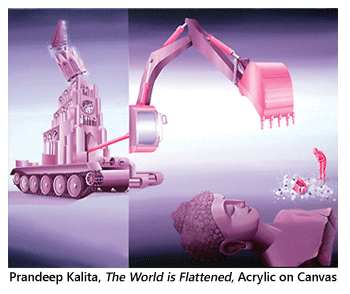 by German and Italian warplanes at the order of the Spanish Nationalist forces, on April 26, 1937, during the Spanish Civil War.
by German and Italian warplanes at the order of the Spanish Nationalist forces, on April 26, 1937, during the Spanish Civil War.
Aakriti Art Gallery, Kolkata, had mounted the exhibition, Social and Political Injustice: Trends in Contemporary Art 2011 on 9th September, just two days prior to a day which is marked as one of the world's worst terrorist attacks and the rise of a figure called Osama Bin Laden and the extremist group of Al Qaida. People are commemorating the day even after a decade. Frugality breeds greed and the super powers are building themselves on this human greed for money, power and ultimate supremacy. Inaugurated by Prof. Subhendu Dasgupta, of the Centre for South East Asian Studies, Calcutta University, and graced by the presence of veteran artists like Bijon Chowdhury, the show continues till the end of the month. A brain child of Vikram Bachhawat,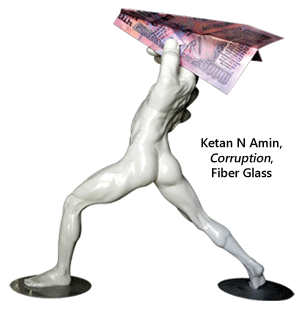 the exhibition showcased as many as fourteen young talents from across the country. Prandeep Kalita - The World Is Flattened (Mixed media on canvas) - shows an overturned head of Buddha and a crane attached to a tractor-like machine, trying to lift the head. The concept reminded one of the opening scene in La Dolce Vita by Frederico Fellini where the Statue of Liberty is being uprooted. The other work by the artist was titled “The Emperor borrows other's clothes” (acrylic on canvas) where again destruction is portrayed through the crumbling of an edifice. In the words of the artist himself, “The current socio and political scenario of the world compels me to question the system in which we live in … The present is becoming more like theatre. What we are witnessing today are clashes within civilization.”
the exhibition showcased as many as fourteen young talents from across the country. Prandeep Kalita - The World Is Flattened (Mixed media on canvas) - shows an overturned head of Buddha and a crane attached to a tractor-like machine, trying to lift the head. The concept reminded one of the opening scene in La Dolce Vita by Frederico Fellini where the Statue of Liberty is being uprooted. The other work by the artist was titled “The Emperor borrows other's clothes” (acrylic on canvas) where again destruction is portrayed through the crumbling of an edifice. In the words of the artist himself, “The current socio and political scenario of the world compels me to question the system in which we live in … The present is becoming more like theatre. What we are witnessing today are clashes within civilization.”
There were seven small canvases that formed a set by the artist Buddhadev Mukherjee. They were all Untitled (Water colour pencil on canvas). In all of them, there were faint suggestions of the human form engaged in some kind of rhythmic dance.  Much of the space in these canvases were left bare and these figures were relegated or huddled to one corner. In another larger work, also Untitled (Mixed media on acid free paper), man is the centre of concentric cosmic spheres inhabited by similar human or other living objects. The set of seven canvases and this single one, somehow, didn't appear to be from the same hand. They were from distinct and separate streams of consciousnesses. Sagar Bhowmik - But for the Grace of God …1 (oil on canvas) shows an aged man (signs of grey on hair and beard) in a sitting position with his bag and a mug against the backdrop of a metallic construction frame. Light plays around the man's clothes; he has a blanket wrapped around him. In But for the Grace of God…2 (Water colour on acid free paper) shows the manly figure once again, but this time in a ramshackle rickshaw. The figure might be the puller himself, a dumb witness to the crumbling of his dreams. The painting is in monotone or monochromatic. The artist has brought out quite successfully the tonal qualities in the figure as well as an inert object like a rickshaw. Says Sagar, “The problem of poverty and unemployment is one that plagues all developing and underdeveloped nations. While on one hand, India and Indians have prospered remarkably in the last decade, the gap between the rich and poor has widened alarmingly. This social injustice fills me with rage,
Much of the space in these canvases were left bare and these figures were relegated or huddled to one corner. In another larger work, also Untitled (Mixed media on acid free paper), man is the centre of concentric cosmic spheres inhabited by similar human or other living objects. The set of seven canvases and this single one, somehow, didn't appear to be from the same hand. They were from distinct and separate streams of consciousnesses. Sagar Bhowmik - But for the Grace of God …1 (oil on canvas) shows an aged man (signs of grey on hair and beard) in a sitting position with his bag and a mug against the backdrop of a metallic construction frame. Light plays around the man's clothes; he has a blanket wrapped around him. In But for the Grace of God…2 (Water colour on acid free paper) shows the manly figure once again, but this time in a ramshackle rickshaw. The figure might be the puller himself, a dumb witness to the crumbling of his dreams. The painting is in monotone or monochromatic. The artist has brought out quite successfully the tonal qualities in the figure as well as an inert object like a rickshaw. Says Sagar, “The problem of poverty and unemployment is one that plagues all developing and underdeveloped nations. While on one hand, India and Indians have prospered remarkably in the last decade, the gap between the rich and poor has widened alarmingly. This social injustice fills me with rage,  but that rage is impotent unless I translate it into something concrete. And this sense of injustice drives me to portray these figures exactly as I see them.”
but that rage is impotent unless I translate it into something concrete. And this sense of injustice drives me to portray these figures exactly as I see them.”
Priyanka Lahiri's Please Help Me Raise My Voice (Oil on canvas) shows just two legs standing before a microphone set on the ground. The viewer can rightly imagine the rest of the story. In Unfortunate Reality (Oil on canvas) the artist has painted a face of childhood with large expressive eyes boring into those of the viewers' with long numerical figures at the bottom. Says she, “Social justice is hard to arrive at and even harder to implement.” Being the sole woman artist in the show, hers was a voice the viewer should definitely pay heed to. Mithun Dasgupta's Celebrating Independence Day (Acrylic on canvas) shows and depicts intra- and inter-regional strifes ongoing in the country through semi-beast, semi-human figures. There are two vultures sitting at the crest with the towering bridge at the back. There is also mention of the Maoist wanted brigade. So the artist is referring here to very recent regional political history. In Reporting from No Man's Land (Acrylic on canvas) he shows mutilated bodies, talking about rape victims, with numerous gaping mouths showing their teeth to the viewer. Again the half-beast, half-human creatures are holding guns here.
Swapan Kumar Mullick - The Carcass of Eros (Synthetic tempera, water proof, on treated paper) - shows a skeletal fish at the centre. A human doll is caught at the vortex of its bones. Surrounding the central image, are spirals of chains and the imagery starts right from the fish's mouth. In It's Her Wish (Conti, soft pastel and ink on paper), the central image of the human embryo. The umbilical cord is rising heavenwards. The two hands drawn on both sides, typifies the hands of fertility. Mullick categorically states, “In the contemporary situation female sexuality is still not her own choice but obliquely ruled by the male dominion.”  Pappu Bardhan - 15 Minutes After Noontime (Acrylic on canvas) shows two feminine unadorned legs and a black umbrella standing side by side. The viewer was strongly reminded of the cover of the best-seller “The Devil Wears Prada”. In It's Part Time (Acrylic on canvas) again a feminine figure wearing the barest lingerie. One wondered at the correlation existing (if any) between the subject of his paintings and the focus of the exhibition. Writes Bardhan, “My work acts as a personal diary and a type of travelogue.”
Pappu Bardhan - 15 Minutes After Noontime (Acrylic on canvas) shows two feminine unadorned legs and a black umbrella standing side by side. The viewer was strongly reminded of the cover of the best-seller “The Devil Wears Prada”. In It's Part Time (Acrylic on canvas) again a feminine figure wearing the barest lingerie. One wondered at the correlation existing (if any) between the subject of his paintings and the focus of the exhibition. Writes Bardhan, “My work acts as a personal diary and a type of travelogue.”
Debashis Dutta - Memory (Water colour on acid free paper) - shows the randomness of human thought processes. There were hundreds of tiny pieces, just like little snapshots out of human memory. In Untitled (Acrylic colour on readymade objects), numerous plastic dolls are spread over the canvas. A blue hued human figure (only back is seen) is putting his leg forward into a jumping position from a spring board. Says Dutta, “Indian miniature painting greatly influences my style of representation.” Among the sculptors, Nantu Behari Das - Cyborg (Fibre glass) a human head with just the suggestion of eyes, ears and nose. Says Das, 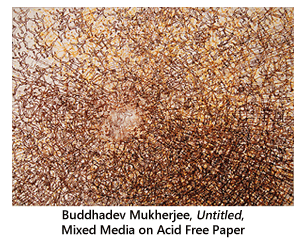 “The head, covered with several electric switches shows the impurity of this society and our too much dependence on machine. Gradually people are losing their natural flexibility and becoming rigid and stiff.” Akhil Chandra Das - Puzzle Box (Bronze, iron and brass) - the figure of an ancient man carrying on his shoulders a rubik's cube like structure wherein emblems of revolvers, stenguns etc. are embossed. Writes Akhil Chandra, “Here, in my work, the man - a metaphor carrying a puzzle box which is basically solved and rejected by the code of terror… This is the puzzle which circulates within us and we are acting as a mean of pivot mechanism.”
“The head, covered with several electric switches shows the impurity of this society and our too much dependence on machine. Gradually people are losing their natural flexibility and becoming rigid and stiff.” Akhil Chandra Das - Puzzle Box (Bronze, iron and brass) - the figure of an ancient man carrying on his shoulders a rubik's cube like structure wherein emblems of revolvers, stenguns etc. are embossed. Writes Akhil Chandra, “Here, in my work, the man - a metaphor carrying a puzzle box which is basically solved and rejected by the code of terror… This is the puzzle which circulates within us and we are acting as a mean of pivot mechanism.”
Tapas Biswas - Girl Carrying Weeds (Painted Aluminium) - a totally white image of a girl carrying twigs and branches. The sheer simplicity in the sculpture was accentuated by the suggestive scene of rusticity and pristine virginity. “To understand the bias against a girl, it is primarily to the family that we turn to… This discrimination is born of cultural and religious values that spring from patriarchal, patrilineal Indian ethos.” In Ketan N. Amin's sculpture, Corruption (Fibre glass), a naked human form whose upper portion is just the fingers of a hand holding the currency of a thousand- rupee note. Here again the figure is in white. Says Amin, “According to my point of view and from the experience of my own life, 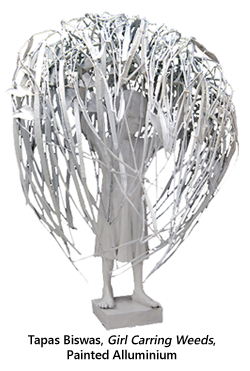 I think that today money is like a joke.” Subrata Biswas - Play with Fish and Childhood (Terracotta) - the pieces have been done in parts and then joined together, ultimately mounted unto a frame. “In an age of competition and comparison, amidst the crushing and crumbling experience of rat race among children; something is surely evaporating - the joy of childhood. Children are under constant pressure of becoming the best, no matter if their laughter is lost… Is there a greater joy under the sun than seeing children laugh to their heart's content?”
I think that today money is like a joke.” Subrata Biswas - Play with Fish and Childhood (Terracotta) - the pieces have been done in parts and then joined together, ultimately mounted unto a frame. “In an age of competition and comparison, amidst the crushing and crumbling experience of rat race among children; something is surely evaporating - the joy of childhood. Children are under constant pressure of becoming the best, no matter if their laughter is lost… Is there a greater joy under the sun than seeing children laugh to their heart's content?”
Partha Guin - Speak Out (Badges installed on engraved PVC board) - has the effect of a woodcut. He has attached circles, squares of laminated logos and has developed his idea around them. It shows vociferous people at the helm to a crowd of the media represented by microphones. In 150 ml Solution (Sticker, print on paper cups), thousands of empty coffee cups are arranged in rows, on each of which have been embossed '150 ml solution' and hung with colourful plastic clips. Each cup had a message to convey. “Protest is one of the medium through which we can express our thoughts and feelings… My protest is not against any individual, it is more universal. And in my work, I represent it, like a 'visual snap shot', its visual protest.”
This protest against society, social norms and customs, the injustices meted out by way of politics and political power, is what was significant and primary concern in this exhibition at Aakriti Art Gallery. All the artists featured in the show were very young and a long road lies ahead each of them. Instead of being mute witnesses, they have been quite articulate in their approach.